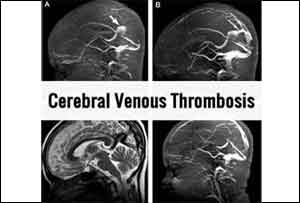- Home
- Editorial
- News
- Practice Guidelines
- Anesthesiology Guidelines
- Cancer Guidelines
- Cardiac Sciences Guidelines
- Critical Care Guidelines
- Dentistry Guidelines
- Dermatology Guidelines
- Diabetes and Endo Guidelines
- Diagnostics Guidelines
- ENT Guidelines
- Featured Practice Guidelines
- Gastroenterology Guidelines
- Geriatrics Guidelines
- Medicine Guidelines
- Nephrology Guidelines
- Neurosciences Guidelines
- Obs and Gynae Guidelines
- Ophthalmology Guidelines
- Orthopaedics Guidelines
- Paediatrics Guidelines
- Psychiatry Guidelines
- Pulmonology Guidelines
- Radiology Guidelines
- Surgery Guidelines
- Urology Guidelines
New Guidelines on Cerebral Venous Thrombosis released

New guidelines for the diagnosis and treatment of cerebral venous thrombosis (CVT) have been issued by the European Stroke Organisation and updates the previous European Federation of Neurological Societies guidelines using a clearer and evidence-based methodology.
The guidelines, published in the European Journal of Neurology, have also been endorsed by the European Academy of Neurology.
Following are the major recommendations of the guidelines
The guidelines, published in the European Journal of Neurology, have also been endorsed by the European Academy of Neurology.
Following are the major recommendations of the guidelines
- Guidelines suggest using magnetic resonance or computed tomographic angiography for confirming the diagnosis of CVT and not routinely screening patients with CVT for thrombophilia or cancer.
- Guidelines recommend parenteral anticoagulation in acute CVT and decompressive surgery to prevent death due to brain herniation.
- Guidelines suggest preferentially using low-molecular-weight heparin in the acute phase and not direct oral anticoagulants.
- Guidelines suggest not using steroids and acetazolamide to reduce death or dependency.
- Guidelines suggest using antiepileptics in patients with an early seizure and supratentorial lesions to prevent further early seizures.
- The said guidelines could not make recommendations concerning duration of anticoagulation after the acute phase, thrombolysis and/or thrombectomy, therapeutic lumbar puncture, and prevention of remote seizures with antiepileptic drugs.
- In women who have suffered a previous CVT, contraceptives containing oestrogens should be avoided. Guidelines suggest that subsequent pregnancies are safe, but use of prophylactic low-molecular-weight heparin should be considered throughout pregnancy and puerperium.
Next Story
NO DATA FOUND

Disclaimer: This site is primarily intended for healthcare professionals. Any content/information on this website does not replace the advice of medical and/or health professionals and should not be construed as medical/diagnostic advice/endorsement or prescription. Use of this site is subject to our terms of use, privacy policy, advertisement policy. © 2020 Minerva Medical Treatment Pvt Ltd